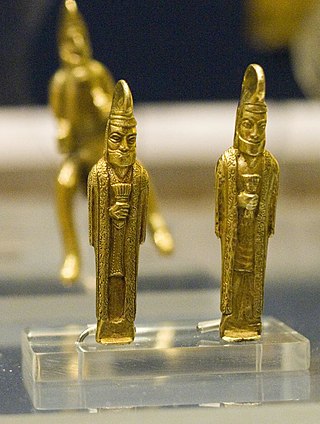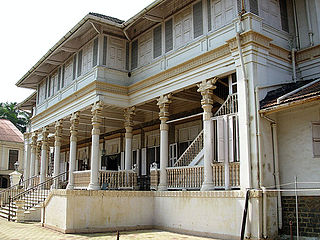Related Research Articles

Zoroastrianism is an Iranian religion and one of the world's oldest organized faiths, based on the teachings of the Iranian-speaking prophet Zoroaster. It has a dualistic cosmology of good and evil within the framework of a monotheistic ontology and an eschatology which predicts the ultimate conquest of evil by good. Zoroastrianism exalts an uncreated and benevolent deity of wisdom known as Ahura Mazda as its supreme being. Historically, the unique features of Zoroastrianism, such as its monotheism, messianism, belief in free will and judgement after death, conception of heaven, hell, angels, and demons, among other concepts, may have influenced other religious and philosophical systems, including the Abrahamic religions and Gnosticism, Northern Buddhism, and Greek philosophy.

Parsis or Parsees are an ethnoreligious group of the Indian subcontinent adhering to Zoroastrianism. They are descended from Persians who migrated to Medieval India during and after the Arab conquest of the Persian Empire in order to preserve their Zoroastrian identity. The Parsi people comprise the older of the Indian subcontinent's two Zoroastrian communities vis-à-vis the Iranis, whose ancestors migrated to British-ruled India from Qajar-era Iran. According to a 16th-century Parsi epic, Qissa-i Sanjan, Zoroastrian Persians continued to migrate to the Indian subcontinent from Greater Iran in between the 8th and 10th centuries, and ultimately settled in present-day Gujarat after being granted refuge by a local Hindu king, Jadi Rana.

A dakhma, also known as a Tower of Silence, is a circular, raised structure built by Zoroastrians for excarnation, in order to avert contamination of the soil and other natural elements by the dead bodies. Carrion birds, usually vultures and other scavengers, consume the flesh. Skeletal remains are gathered into a central pit where further weathering and continued breakdown occurs.

Bapsi Sidhwa is a Pakistani novelist of Gujarati Parsi Zoroastrian descent who writes in English and is a resident in the United States.
Nora Elisabeth Mary Boyce was a British scholar of Iranian languages, and an authority on Zoroastrianism. She was Professor of Iranian Studies at the School of Oriental and African Studies (SOAS) of the University of London. The Royal Asiatic Society's annual Boyce Prize for outstanding contributions to the study of religion is named after her.

Yazata is the Avestan word for a Zoroastrian concept with a wide range of meanings but generally signifying a divinity. The term literally means "worthy of worship or veneration", and is thus, in this more general sense, also applied to certain healing plants, primordial creatures, the fravashis of the dead, and to certain prayers that are themselves considered holy. The yazatas collectively are "the good powers under Ahura Mazda", who is "the greatest of the yazatas".

The Reverend James Hope Moulton was a British non-conformist divine. He was also a philologist and made a special study of Zoroastrianism.
Udvada is a town situated in Pardi taluka in the Valsad district in the state of Gujarat, India. Udvada is a coastal town located around 24 km from the Valsad city. The Zoroastrian temple, Udvada Atash Behram is situated here.

A Mobed, Mowbed, or Mobad is a Zoroastrian cleric of a particular rank. Unlike an herbad (ervad), a mobed is qualified to serve as celebrant priest at the Yasna ceremony and other higher liturgical ceremonies. A mobed is also qualified to train other priests.

The persecution of Zoroastrians has been recorded throughout the history of Zoroastrianism, an Iranian religion. The notably large-scale persecution of Zoroastrians began after the rise of Islam in the 7th century CE; both during and after the conquest of Persia by Arab Muslims, discrimination and harassment against Zoroastrians took place in the form of forced conversions and sparse violence. Muslims who arrived in the region after its annexation by the Rashidun Caliphate are recorded to have destroyed Zoroastrian temples, and Zoroastrians living in areas that had fallen under Muslim control were required to pay a tax known as jizya.

Maneckji Nusserwanji Dhalla, also abbreviated M. N. Dhalla, was a Pakistani Zoroastrian priest and religious scholar.
Dr. Sir Ervad Jivanji Jamshedji Modi (1854–1933), who also carried the title of Shams-ul-Ulama, was a prominent Zoroastrian Parsi-Indian priest, scholar and community leader in Bombay. One of "the most decorated priests in history", he wrote over 70 books, produced over 120 scholarly papers on Zoroastrian history, traveled and researched into Zoroastrian affairs extensively and was instrumental in organizing the Parsi community in India. During his lifetime he had been called "the greatest living authority on the ancient history and customs of the Parsis."

Jamshedji Sorab Kukadaru was a Zoroastrian priest in Mumbai, India. He was revered by Zoroastrians for a number of miracles he is believed to have performed. He was well known by his contemporaries for his simple lifestyle and asceticism, as well as his unflinching adherence to priestly purity rules. Most of his life is said to have been spent in prayer.

Zoroastrianism in India has significant history within the country. Zoroastrians have lived in the Indian subcontinent since the Sasanian period. The Zoroastrians also moved to India in successive migrations during the Islamic period. The initial migration following the Muslim conquest of Persia has been canonized as a religious persecution by invading Muslims. Zoroastrianism meanwhile suffered a decline in Iran after the conquests. Subsequent migrations also took place after the attempts by Safavids to convert their subjects to Shiism.

The Iranshah Atash Behram, also known as the Udwada Atash Behram is a sacred fire housed in a temple in Udvada, Gujarat on the west coast of India. It is the first of the eight fire temples of the Zoroastrian religion in the country. The Atash Bahram, meaning "Victorious Fire", is the oldest fire temple in India, dated to the eighth century, and represents the historical cultural and religious links with Iran. The current temple housing the sacred fire was built in 1742 by Motlibai Wadia from Bombay. The temple structure, built spaciously, is well decorated and contains the Dasturji Kaiyoji Mirza hall and a museum. The main hall of the temple is accessed through a two-stage staircase. The temple attracts Zoroastrian pilgrims from all parts of India, Pakistan, and from around the world.
Parsiana is a semi-monthly magazine written in English and published in Bombay for the Zoroastrian community. As of 2019, it was in its 55th year of publication.
There was communal violence between Parsis and Bohra Muslims in May 1857 in Broach in India.

The Revayats are a series of exchanges between the Zoroastrian community in India and their co-religionists in early modern Iran. They have been ascribed the same importance of the Talmud to Judaism by Jivanji Jamshedji Modi.
References
- ↑ Mention of Godrej Sidhwa's death
- ↑ "Daily Times - Leading News Resource of Pakistan - Parsis celebrate Nauroz by honouring priests". www.dailytimes.com.pk. Archived from the original on 2007-08-06. Retrieved 2008-03-27.